Hypospadias
Hypospadias is a male birth defect in which the opening of the tube that carries urine from the body (urethra) develops abnormally, usually on the underside of the penis, anywhere from below the end of the penis to the scrotum. Instead of opening at the tip of the glans of the penis, a hypospadic urethra opens anywhere along a line (the urethral groove) running from the tip along the underside (ventral aspect) of the shaft to the junction of the penis and scrotum or perineum.
Hypospadias are among the most common birth defects of the male genitalia (second to cryptorchidism), but widely varying in incidence. The incidence of hypospadias around the world has been increasing in recent decades. In the United States, two surveillance studies reported that the incidence had increased from about 1 in 500 total births (1 in 250 boys) in the 1970s to 1 in 250 total births (1 in 125 boys) in the 1990s. Although a slight worldwide increase in hypospadias was reported in the 1980s, studies in different countries and regions have yielded conflicting results and some registries have reported decreases.
A distal hypospadias may be suspected even in an uncircumcised boy from an abnormally formed foreskin and downward tilt of the glans.
The urethral meatus opens on the underside of the glans penis and on the penile body in about 50-75% of cases; these are categorized as distal forms. Proximal forms (when the urethra opens on the shaft starts from the penoscrotal angle to the perineum), occur in up to 20 and 30% of cases. The more severe degrees are more likely to be associated with chordee, in which the phallus is incompletely separated from the perineum or is still tethered downwards by connective tissue, or with undescended testes (cryptorchidism).
Associated anomalies
Mild hypospadias most often occurs as an isolated birth defect without detectable abnormality of the remainder of the reproductive or endocrine system. However, a minority of infants, especially those with more severe degrees of hypospadias will have additional structural anomalies of the genitourinary tract. Up to 10% of boys with hypospadias have at least one undescended testis, and a similar number have an inguinal hernia. An enlarged prostatic utricle is common when the hypospadias is severe (scrotal or perineal), and can predispose to urinary tract infections, pseudo-incontinence, or even stone formation.
Etiology
In most cases, the cause of this birth defect is not fully understood. Treatment with hormones such as progesterone during pregnancy may increase the risk of hypospadias. Certain hormonal fluctuations, such as failure of the fetal testes to produce enough testosterone or the failure of the body to respond to testosterone, increase the risk of hypospadias and other genetic problems. Sometimes hypospadias is inherited.
There also may be an increased risk of hypospadias in male infants from late pregnancy or those conceived with in vitro fertilization (IVF). Correlation with IVF may be due to the mother’s exposure to progesterone, a natural hormone, or to progestin, a synthetic form of progesterone, administered during the IVF process.
Prenatal testosterone, converted in the genital skin to dihydrotestosterone, causes migration of skin fibroblasts to fully enclose the urethral groove in fetal males, normally resulting in an enclosed penile urethra by the second trimester of pregnancy. Failure of adequate prenatal androgen effect is therefore thought to be involved in many cases, making severe hypospadias a very mild form of intersex (under-virilization of a genetic male). Since postnatal androgen deficiency can only be demonstrated in a minority of cases, it has been proposed that transient deficiency of testosterone can occur during critical periods of fetal genital development, due to elevation of anti-müllerian hormone or more subtle degrees of pituitary-gonadal dysfunction. More recently, abnormalities of transcription factors have been proposed.
In a minority of cases, a postnatal deficiency of androgens, or reduced sensitivity to androgens (testosterone and dihydrotestosterone) can be demonstrated. These are often associated with a chordee, and in severe cases a residual perineal urogenital opening and small phallus. This combination of birth defects is referred to as pseudovaginal perineoscrotal hypospadias and is a part of the spectrum of ambiguous genitalia. Postnatal testosterone treatment does not close the urethra. Genetic factors are likely involved in at least some cases, as there is about a 7% familiar recurrence risk. A 2010 Article found a 2.5 times increase in the condition for boys with a specific genetic defect that was carried on the X (maternally contributed sex) chromosome.
Treatment
Distal forms (glanular, subglanular, midshaft) are repaired between 12 and 18 months of age. There are more than 200 operative techniques and their modifications. Success rate is approximately 90 to 95%. Surgical repair of distal hypospadias is almost always successful after a single procedure, usually performed by a pediatric urologist or a plastic surgeon until the child is one year old.
When the hypospadias is severe degree, or there are associated birth defects such as chordee or cryptorchidism, the best management can be more complicated. A karyotype and endocrine evaluation should be performed to detect intersex conditions or hormone deficiencies. If the penis is small, testosterone or human chorionic gonadotropin (hCG) injections may be given to enlarge it prior to surgery. Surgical repair of severe hypospadias may require multiple procedures and mucosal grafting. Preputial skin is often used for grafting and circumcision should be avoided prior to repair.
Complications and secondary repair
In a minority of patients with severe hypospadias surgery produces unsatisfactory results, such as scarring, curvature, or formation of urethral fistulas, diverticula, or strictures. A fistula is an unwanted opening through the skin along the course of the urethra, and can result in urinary leakage or an abnormal stream. A diverticulum is an “outpocketing” of the lining of the urethra which interferes with urinary flow and may result in post-urination leakage. A stricture is a narrowing of the urethra severe enough to obstruct flow. Reduced complication rates even for third degree repair (e.g., fistula rates below 5%) have been reported in recent years from centers with the most experience, and surgical repair is now performed for the vast majority of infants with hypospadias. Special problem presents urethral complications in adulthood, after primary repaired hypospadias in childhood. In these cases, standard principles for urethral reconstruction in adults should be performed for successful outcome.
CASE 1
Distal hypospadias
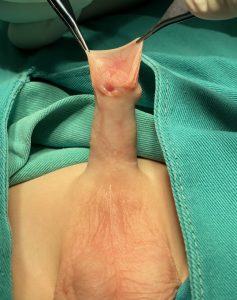 Distal hypospadias with abundant dorsal skin.
Distal hypospadias with abundant dorsal skin.

Distal hypospadias – ventral view.
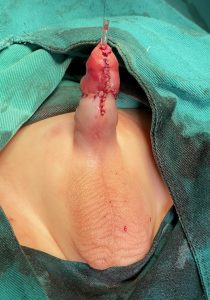 Result after surgery – ventral view.
Result after surgery – ventral view.
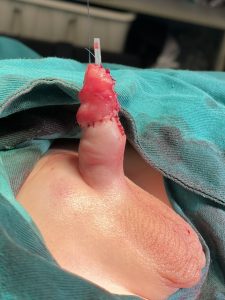 Result after surgery – lateral view.
Result after surgery – lateral view.

 Appearance 10 years after hypospadias repair.
Appearance 10 years after hypospadias repair.
CASE 2
Penoscrotal hypospadias
 Penoscrotal hypospadias with severe ventral chordee.
Penoscrotal hypospadias with severe ventral chordee.
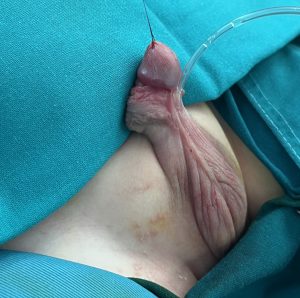 Severe ventral curvature with insuficient ventral skin.
Severe ventral curvature with insuficient ventral skin.

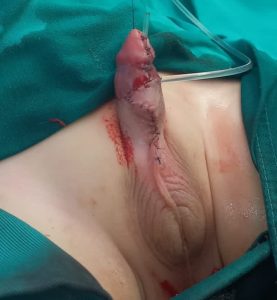
Result after surgery. Correction of chordee, urethral reconstruction and penile skin reconstruction were done.

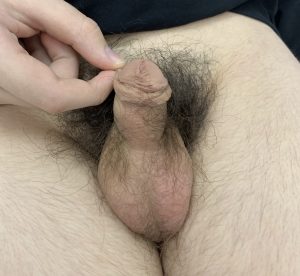
Outcome 12 years after surgery.
CASE 3
Scrotal hypospadias – one stage repair
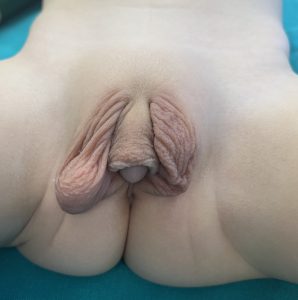 Preoperative appearance. Scrotal hypospadias with bifid scrotum and penoscrotal transposition.
Preoperative appearance. Scrotal hypospadias with bifid scrotum and penoscrotal transposition.
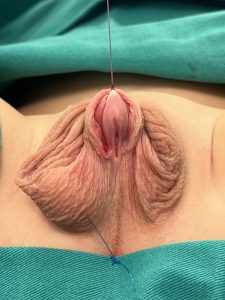
Severe chordee is present.
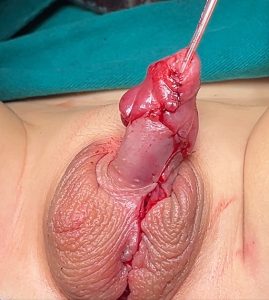
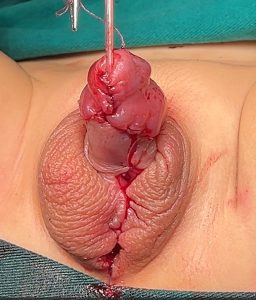
Result after one stage penile and urethral reconstruction. Good relationship between penis and scrotum is achieved.
CASE 4
Scrotal hypospadias – one stage repair
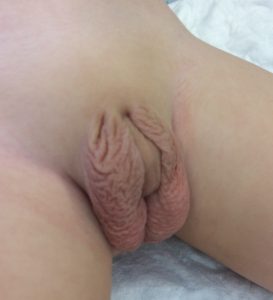 Preoperative appearance. Severe penoscrotal transposition.
Preoperative appearance. Severe penoscrotal transposition.
 Severe hypospadias with marked ventral curvature.
Severe hypospadias with marked ventral curvature.
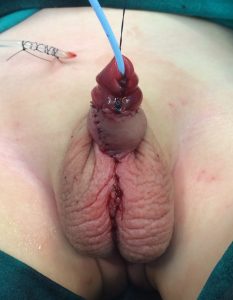 Outcome after one stage repair (ventral view)
Outcome after one stage repair (ventral view)
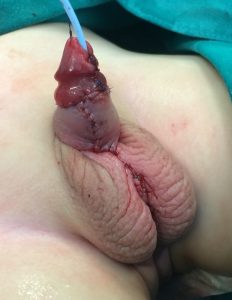 Outcome after one stage repair (lateral view)
Outcome after one stage repair (lateral view)
CASE 5
Scrotal hypospadias – WATCH technique
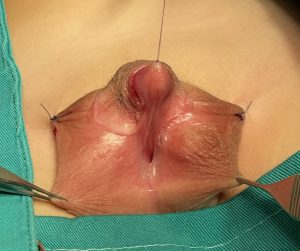 Scrotal hypospadias with severe curvature and small penis.
Scrotal hypospadias with severe curvature and small penis.
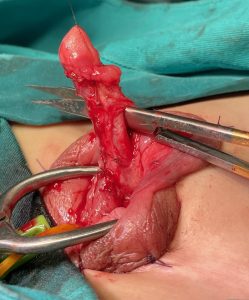 Penile straightening and lengthening after transection of short urethral plate.
Penile straightening and lengthening after transection of short urethral plate.
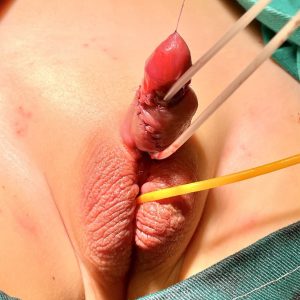
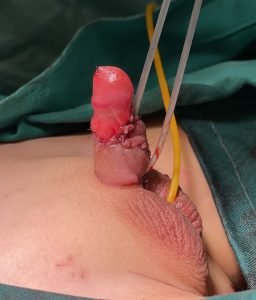 Outcome after one stage repair with BMG (WATCH technique) – straightening and lengthening of the penis, urethral reconstruction, scrotoplasty, penile skin reconstruction. Urethral anastomosis is left for the second stage.
Outcome after one stage repair with BMG (WATCH technique) – straightening and lengthening of the penis, urethral reconstruction, scrotoplasty, penile skin reconstruction. Urethral anastomosis is left for the second stage.
 Outcome 6 months after surgery.
Outcome 6 months after surgery.
 Outcome one year after surgery – home photo.
Outcome one year after surgery – home photo.
 Outcome one year after surgery – home photo.
Outcome one year after surgery – home photo.
CASE 6
Scrotal hypospadias – two stage
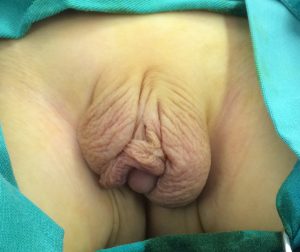 Severe proximal hypospadias
Severe proximal hypospadias
 Abundant dorsal skin.
Abundant dorsal skin.
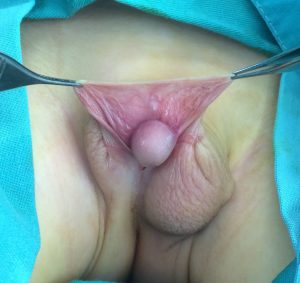
Small clitoriform penis with penoscrotal transposition.
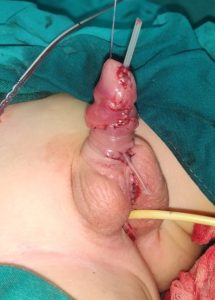
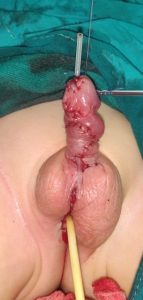
Outcome after first stage. Penile lengthening and straightening, urethral reconstruction, penile skin reconstruction are done.
CASE 7
Adult hypospadias repair
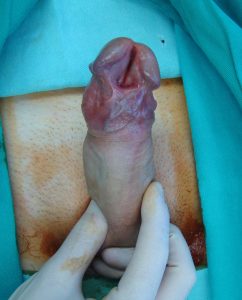
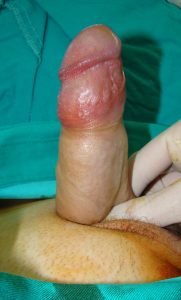 Preoperative appearance.
Preoperative appearance.
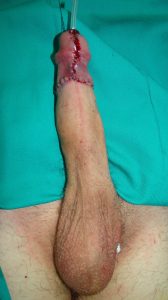
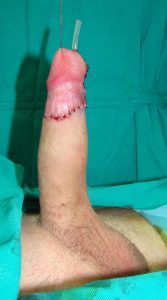 Final result.
Final result.
CASE 8
Failed hypospadias repair in adult
 Trapped penis after multiple failed hypospadias repair.
Trapped penis after multiple failed hypospadias repair.
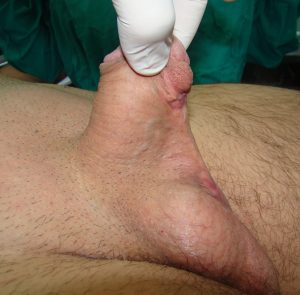 Trapped penis with short urethra.
Trapped penis with short urethra.
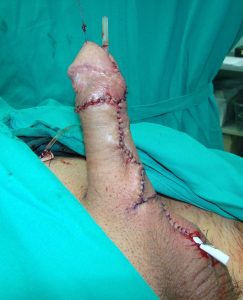 Final aspect. Penile lengthening, urethroplasty, glansplasty and penile skin reconstruction are done.
Final aspect. Penile lengthening, urethroplasty, glansplasty and penile skin reconstruction are done.
 Penis is lengthened and straightened, urethroplasty is done, glans is reconstructed
Penis is lengthened and straightened, urethroplasty is done, glans is reconstructed
1. Djordjevic ML (2014). Hypospadias surgery: challenges and limits. Hauppauge, New York: Nova Science Publishers, Inc.
2. Djordjevic ML, Kojovic V, Bizic M, Majstorovic M, Vukadinovic V, Korac G. “Hanging” of the buccal mucosal graft for urethral stricture repair after failed hypospadias.J Urol. 2011 Jun;185(6 Suppl):2479-82. Epub 2011 Apr 27.
3. Majstorović M, Bižić M, Kojović V, Stojanović B, Krstić Z, Đorđević M. Urethral reconstruction in severe hypospadias using buccal mucosa graft and penile skin flap. Srpski arhiv za celokupno lekarstvo, vol. 139, iss. 9-10, pp. 631-637, 2011 (Serbian).
4. Kojovic V, Majstorovic M, Bizic M, Korac G, Djordjevic M. Adult urethral strictures in previous hypospadias patients. Urology 76 (Supplement 3A), September 2010, pS20.
5. Majstorovic M, Bizic M, Kojovic V, Ducic S, Djordjevic M, Extended Snodgrass technique with dorsal dartos flap wraping in the treatment of proximal hypospadias, 42nd Annual Meeting of Pacific Association of Pediatric Surgery, Hong Kong, 2009, p69-70, (P037).
6. Kojovic V, Majstorovic M, Bizic M, Ducic S, Korac G, Djordjevic M. Hanged ventral buccal mucosa graft in the treatment of urethral stricture after failed hypospadias repair. Eur Urol Suppl, 2009;8(8):649.
7. Majstorovic M, Bizic M, Kojovic V, Stojanovic B, Krstic Z, Djordjevic M. Treatment of proximal hypospadias using extended Snodgrass technique with dorsal dartos flap wraping. Eur Urol Suppl, 2009;8(8):649-50.
8. Djordjevic M., Santucci R., Perovic S.: Combined buccal mucosa graft and penile flap for urethral reconstuction in failed hypospadias repair. J Urol 2008;179(4):305.
9. Djordjevic ML, Majstorovic M, Stanojevic D, Bizic M, Ducic S, Kojovic V, Vukadinovic V, Korac G, Perovic S. One-stage repair of severe hypospadias using combined buccal mucosa graft and longitudinal dorsal skin flap. Eur J Pediatr Surg. 2008;18(6):427-30.
10. Djordjevic ML, Majstorovic M, Stanojevic D, Bizic M, Kojovic V, Vukadinovic V, Korac G, Krstic Z and Perovic S. Combined buccal mucosa graft and dorsal penile skin flap for repair of severe hypospadias. Urology, 2008 May, 71(5):821-825.
11. Djordjevic M, Santucci R, Perovic S. Combined buccal mucosa graft and penile flap for urethral reconstruction in failed hypospadias repair. Urology, 2007; 70(suppl.5):183 (abs.V05.07).
12. Djordjevic ML. Reply to dr Nuhoglu et al.’s letter to the editor re: Miroslav L. Djordjevic, Sava V. Perovic, Zoran Slavkovic and Nenad Djakovic. Longitudinal dorsal dartos flap for prevention of fistula after a Snodgrass hypospadias procedure. Eur Urol. 2007 Mar;51(3):857.
13. Djordjevic ML, Perovic SV, Slavkovic Z, Djakovic N. Longitudinal dorsal dartos flap for prevention of fistula after a Snodgrass hypospadias procedure. Eur Urol, 2006;50(1):53-7.
14. Bubanj TB, Perovic SV, Milicevic RM, Djordjevic M. Sexual behavior and sexual function of adults after hypospadias surgery: a comparative study. J Urol. 2004 May;171(5):1876-9.
15. Djordjevic M, Perovic S, Vukadinovic V. One stage repair of penoscrotal transposition with hypospadias. Eur Urol, 2001;